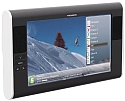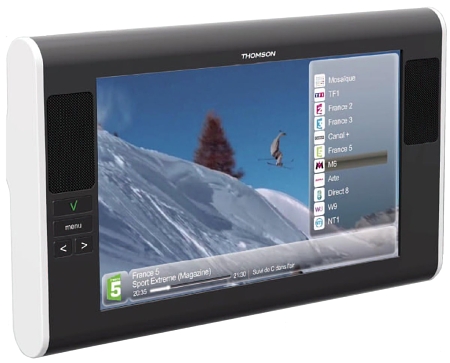Linux tablet delivers IP-TV, other services over WiFi
Sep 11, 2007 — by LinuxDevices Staff — from the LinuxDevices Archive — 4 views A European vendor of multi-service broadband gateways has used Linux and a handful of Texas Instruments (TI) silicon to build a neat-looking WiFi tablet capable of delivering IP-TV wirelessly throughout the home. Thomson's “WiFi Tablet” can deliver a range of other advanced services, too.
A European vendor of multi-service broadband gateways has used Linux and a handful of Texas Instruments (TI) silicon to build a neat-looking WiFi tablet capable of delivering IP-TV wirelessly throughout the home. Thomson's “WiFi Tablet” can deliver a range of other advanced services, too.
By connecting wirelessly, the WiFi Tablet eliminates the need to run cable and install extra set-top boxes. It has an 8-inch WVGA (800×480) pixel LCD touchscreen, and “powerful” stereo speakers, according to the company.
In addition to delivering IP-TV, Thomson's WiFi Tablet can reportedly deliver a range of next-generation services, with FOTA (firmware over-the-air) upgrades allowing for service additions and subscriber upgrades. Suggested services include:
- Digital photo frame with remote photo printing service tie-in
- Wireless music playback
- “MyInfoKiosk” RSS-based content push services
- Telephone services — i.e., with Vericall Edge or another third-party stack supporting DaVinci

Thomson WiFi Tablet
(Click to enlarge)
What's under the hood?
The WiFi Tablet is based on a TI DaVinci TMS320DM6441, an SoC (system-on-chip) that combines an ARM9 core clocked at 202.5 MHz with a TMS320C64x+ DSP (digital signal processor) core clocked at 405 MHz. The SoC also integrates numerous PC-style interfaces.

TMS320DM6441 SoC architecture
(Click to enlarge)
Additionally, the dual-core SoC integrates a video/imaging coprocessor (VICP) said to be capable of offloading many video and image processing tasks from the DSP core, when used with codecs available from TI. Thomson's WiFi tablet also uses TI's H.264 and MP3 codecs; other codecs available for the SoC include MPEG4, Dolby Digital decoding, and DTS decoding.
The WiFi Tablet hardware design also incorporates a TI power management companion chip and TI analog parts, such as audio amplifiers. TI says it collaborated on the design, which it said is Thomson's first product based on DaVinci technology.
Other features include a USB-A interface, optional charging dock, and “access to remote and local multimedia contents,” Thomson said. The last feature suggests that the WiFi tablet's Linux-based software reference design may incorporate UPnP libraries for local content access, and either gstreamer and/or helix libraries for access to remote streams. However, few specifics of the stack appear to be public at this time.
Bruno Fabre, VP of customer premises systems at Thomson, stated, “Our WiFi multimedia tablet is an excellent mix of performance, flexibility and power efficiency.”
Availability
Thomson launched the WiFi tablet in March. Customer wins were not divulged. Pricing, too, was not stated.
Another Linux-based WiFi tablet, Nokia's N800, will be distributed by Sprint next year as a WiMAX terminal.
This article was originally published on LinuxDevices.com and has been donated to the open source community by QuinStreet Inc. Please visit LinuxToday.com for up-to-date news and articles about Linux and open source.